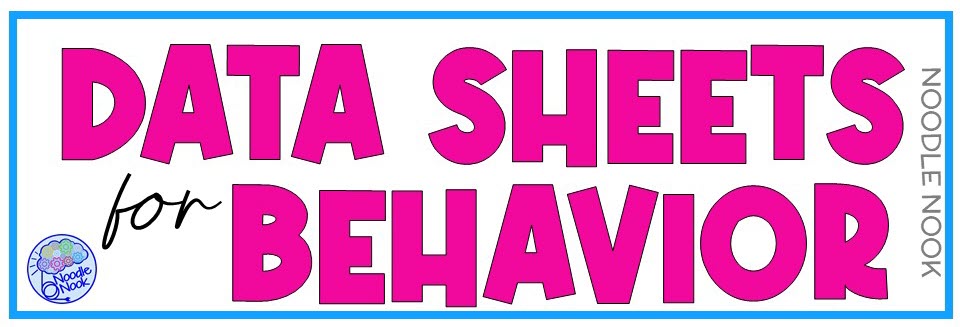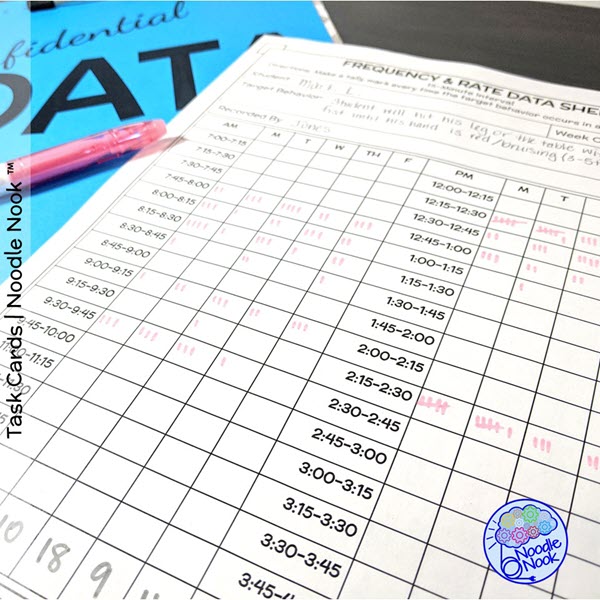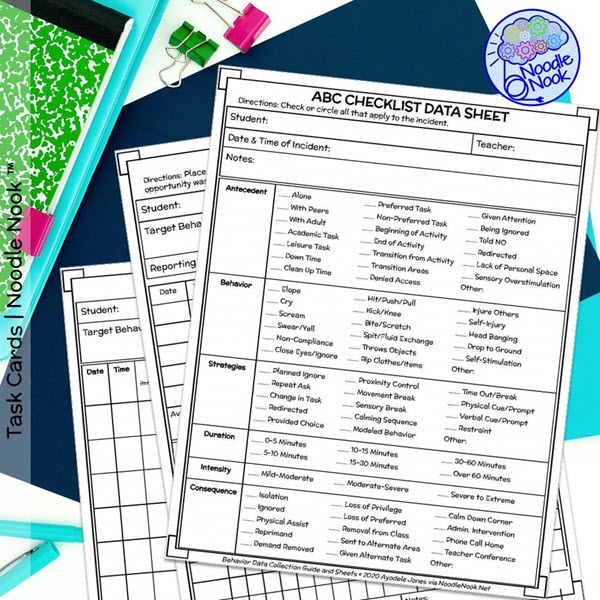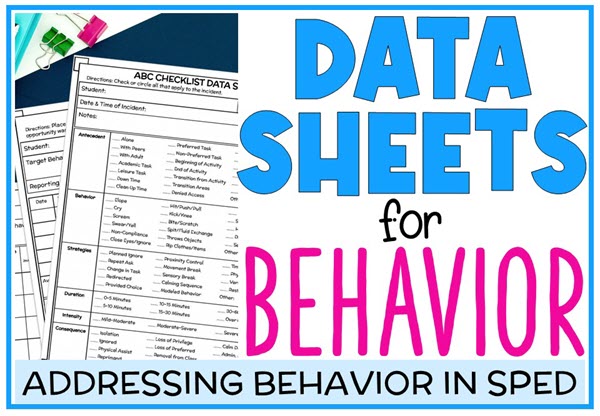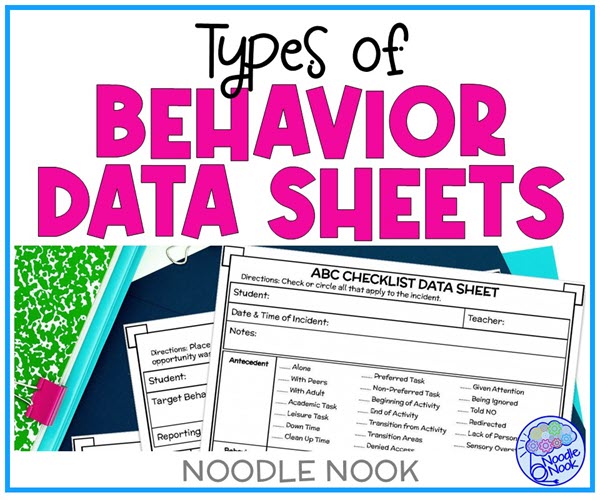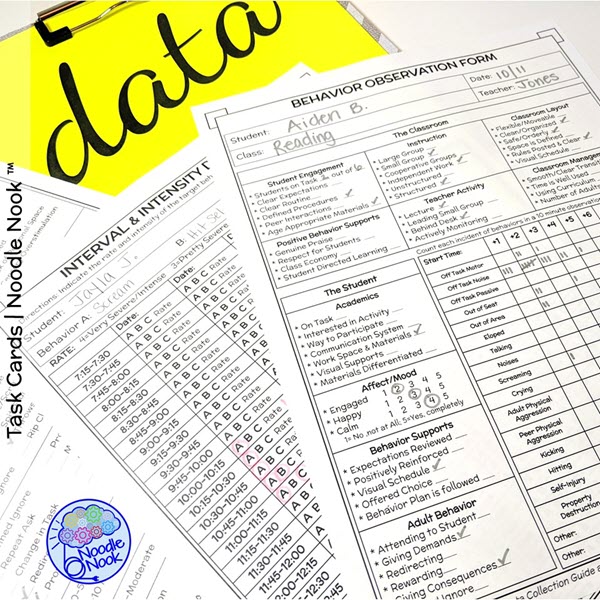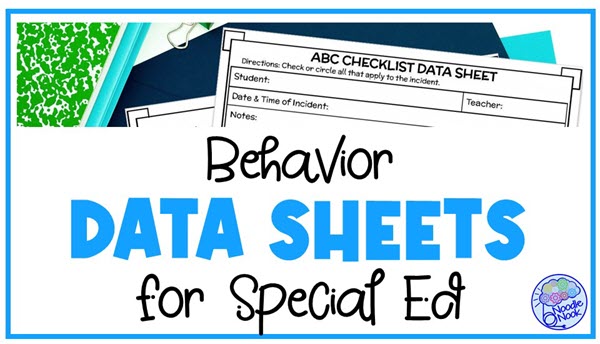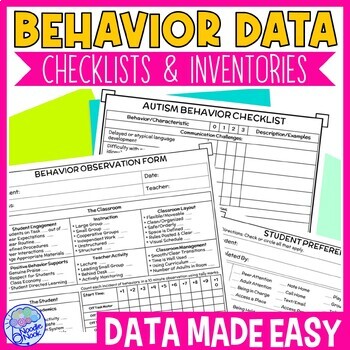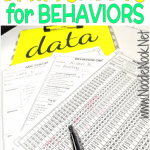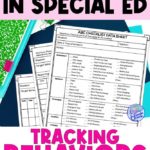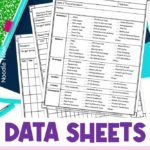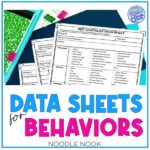Am I the only one that loves data sheets? Okay, I totally admit it- I am a data geek. I love behavior data collection, tracking growth, and making plans with data in mind.
There. My dirty little secret is out.
I love behavior data sheets ❤️️.
Now know that everyone doesn’t have a love, love relationship with data. Especially with behavior data. Academic data is pretty straightforward, but behavior data collection has a ton of variables you have to consider. You really have to think about what the behaviors you need to track look like so you can choose the best method to collect information.
That can be a job… a tough one. If you have a student screaming every 30 seconds and you’re trying to pinpoint the trigger, a standard data sheet won’t do. You need the right behavior data collection sheets! What’s more, after you take the time to put a behavior plan in place, you want a behavior data collection method to determine if things are getting better or worse.
Let’s break down what data collection is for special education students, how to take data in special ed, which behavior data sheets will work best for your students, and how to track behavior in the classroom.
What is Data Collection in Special Education?
Data collection is the process of recording behavior, performance, or progress on skills and tasks for students with an individual education plan (IEP) or behavior intervention plan (BIP). That includes behaviors, academics, and also functional skills, like washing hands or cooking.
Data collection is the foundation of an IEP and student plans cannot be meaningful or effective without a baseline data, progress monitoring, and a consistent system of data collection.
How Do You Take Data in Special Education?
When it comes to tracking behaviors, sometimes you need specific behavior data collection sheets, not just some incident reports and post-it notes. Usually, you’re looking for the rate of completing a task, the accuracy of completing a task, or the duration and intensity of a behavior or skill.
In order to do this accurately and effectively, you have to start with the right sheet. You wouldn’t want to try to record intensity on an accuracy data sheet. Not only would it be confusing, whatever you recorded wouldn’t be capturing the information you really needed.
Once you have the right sheet, data collection is a process of:
- Identifying the skill or behavior you want to track
- Providing the needed materials for a data trial to happen (maybe that’s a math worksheet to track accuracy of calculation, a greeting to measure social skill, or a recipe card and ingredients for cooking).
- Recording the outcomes, with attention to prompts and cues. (That’s a post for another day though.)
How Do You Track Behavior in the Classroom?
When it comes to recording behavioral data, there are some specific things you need to do. How you track behavior in the classroom will help you draft an effective behavior plan.
First things first. Start with an ABC checklist. ABC in behavior data collection stands for Antecedent Behavior Consequence.
The Antecedent
The antecedent with ABC behavior data is the thing that happened before the behavior. It’s the trigger for the behavior. Being asked to work, a loud noise, not getting a desired item. All of these may be the antecedent to a behavior.
The Behavior
Behavior is the B in the ABC data collection process. The behavior is the thing the student does. This is usually easy to record. You know what the behavior looks like… that’s why you need this behavior data in the first place! Be specific with your description here and record the behavior without judgement. ‘The student indiscriminately hits others within arms-length with a closed fist’ sounds better and gives more information than ‘she hits everybody’.
The Consequence
The C in ABC is the consequence. A lot of times this is harder to pinpoint. The consequence may be internal and you may not see it or connect the dots. Maybe the student gets out of working, maybe they get attention, or maybe they get a tangible item to stop. Either way, this will be the key to changing the behavior.
After you complete an ABC checklist, you can usually identify the type of data collection that will be best for the student. If you’re still not sure, check out the resource here for a complete explanation for when each type of data sheet is appropriate.
What Makes a Good Data Sheet?
I can tell you, a bad data sheet is a pain in the pen. It’s irritating when you have a tool that is wrong for the job. They have to be easy to use, simple to implement, and a breeze to analyze.
I love this pack of data sheets because it comes with a guide sheet for each type of data collection type. Plus there is a decision guide that walks you through choosing the right sheet. To sum that up, you get help picking the right data sheet and shows you exactly how to calculate the data with examples. Boom! #TeacherWin
Types of Behavior Data Sheets
There are a crap ton of different data sheets. When it comes to behavior, I have found these are the most convenient to have around and get used the most:
ABC Data Sheets
Antecedent-Behavior-Consequence data sheets are super popular for us sped teachers working on behavior management. They ask you to document the behavior as well as what happened immediately before and after the behavior happened.
I like having a blank box version to write narratives, but sometimes that isn’t the easiest thing to squeeze into a teacher’s day.
I created a checklist version of the ABC data sheet to make it way easier to document a behavior without having to suck what little time and energy we have after a tough day in the classroom.
Frequency Data Sheets
Frequency is looking at how often a behavior is happening. It’s easy to start seeing trends when you take some time to track incidences. I like having sheets that break the behavior into 30 or 15 minute increments, but my favorite frequency sheet is a simple self-graphing sheet that really makes a visual statement for how often a behavior is happening.
They look great when you have to present data to parents or behavior interventionists who need to quickly see what is going on with a student. This is some ❤️️ superlove ❤️️ here!
Intensity Data Sheets
When a behavior happens a lot, you may need to focus on how bad the situations get. That is not done on a frequency chart- you won’t get the results you want. Intensity data sheets are golden in this situation! Looking at how severe a situation gets when a behavior occurs can help you get a better behavior plan in place.
Intensity & Interval Data Sheets
What happens when you combine intensity and interval? You get the data equivalent of PB&J! They go together like peas and carrots. And, best of all, the combo sheets in this set allow you to track multiple behaviors on the same page. Whoop!
Additional Sheets for Data Collection
When you add in Duration, Latency, and Opportunities data sheets to the mix, you legit have all the data sheets you need. It’s the bonus sheets in this set that really make it a winner. I’ve added my favorite behavior observation forms, a narrative version as well as a checklist version that makes life super easy.
There is also a preference survey that you can use to pinpoint a student’s preferred reinforcers that will help you make a plan that works.
The final bonus that will really rock your BIPs is an intervention idea sheet. Sometimes it can feel like you’re not sure what to try to get a behavior under wraps. Having a document like this in your toolbelt is a great planning tool to get a BIP that is gonna work! Have a kid that’s sensory motivated who needs some relief, maybe a HELP visual or a Calm Down Corner will help… whatever the function of the behavior, this bonus will help you find an intervention!
Cute Covers for Behavior Data
Okay… the function of data collection is super fun and exciting, but you also want it to look pretty. I like to make a colorful clipboard cover to keep data confidential as well as some designer binder covers to make things look Pinterest-perfect.
The Most Awesomest Data Sheets
Okay, so gushing aside, I really do love data collection and analysis. I know you want to make the process easier and using this super-supported set of data collection sheets for behavior is the best way. This set is complete with all the covers, 16 different data sheets for behavior, 8 guiding documents to help choose the right data tool, and 5 extra supporting docs too. That means 38 stellar pages to make your behavior data collection simpler and more meaningful too. Click here to see more and get yours today!
Behavior Data Collection FAQ
Behavior data collection is the process of systematically gathering information about a person’s behavior. This information can be used to understand and modify behavior. Behavior data collection can be done in different ways and with different methods depending on the purpose of the study or intervention.
There are many different methods of behavior data collection, including continuous data collection methods, such as event recording, duration recording, and partial interval recording, and discontinuous measurement methods, such as momentary time sampling, whole interval recording, and frequency measures. Each method has its own advantages and disadvantages, and the selection of the appropriate method depends on the specific information being collected and the desired outcome.
Special education teachers and their teams can benefit significantly from behavior data collection. Teachers can modify teaching strategies and develop effective behavior change plans by tracking student progress and collecting accurate behavior data. This data can also help teams make informed decisions about individualized education plans (IEPs) and monitor progress toward specific goals.
Behavior data collection can be used to track many different behaviors, including high-rate behaviors, duration-based behaviors, and maladaptive behavior. Examples include the occurrence of a behavior, the frequency of the behavior, the latency of the behavior, and the duration of the behavior.
Accurate behavior data is critical for accurate data analysis and the development of effective behavior change strategies. Errors in behavior data can lead to incorrect conclusions and ineffective interventions. Accurate measurement is also an essential part of functional behavioral assessments.
A set of printable data sheets can provide an easy and convenient way to collect and record behavior data. These sheets can be customized to meet the specific needs of different users and can be used to track behaviors over time, monitor progress toward IEP goals, and provide a complete record of behavior. Additionally, printable data sheets can help reduce human error and ensure accurate measurement of behavior.
Behavior data can be collected in real time by recording the occurrence of a target behavior using different methods. When to use which data system is explained clearly in the behavior data sheet set in the Noodle Nook store. You can take make recording data with frequency measures using printable sheets, mobile apps, or by having paraeducators help in getting data points using an online format, like Google Forms. Even simple tally marks on a post it can be used to keep track of the number of times the behavior occurs, providing an accurate record of the behavior over time. That means latency data, duration data, or frequency data through an observation period. It’s all about the right data form.
Real-time behavior data collection can help special education teachers and their teams monitor student progress and modify teaching strategies to address specific behaviors or goals.
Teachers can use checklists, completion logs, or digital platforms to collect data on homework assignments and track student progress.
Behavior rating scales are standardized tools that can be used to collect data on specific behaviors or traits, such as attention, impulsivity, or aggression.
School psychologists can conduct functional behavioral assessments, develop behavior change plans, and provide consultation and support to teachers and families.
Average latency refers to the amount of time that elapses between a stimulus or event and the occurrence of a behavior. It’s a fancy way to say wait time. It can be measured using latency recording methods, such as momentary time sampling or whole interval recording.
Teachers or behavior analysts can use data forms, tally sheets, or digital platforms to collect data on specific behaviors or events during face-to-face interactions. They are essential when addressing a problem behavior, especially with ABA data collection. This is perfect in an ABC data sheet or by using a behavior rating scale.
Positive behavior support strategies, such as reinforcement, prompting, or visual supports, can be used to decrease problem behaviors and increase appropriate behaviors in students with autism spectrum disorders. Make your choices on what to use to be most effective based on student data. Data-driven decisions are everything!
Noodle Nook printed behavior data sheets and guides are the best! You should check them out and then add them to your classroom resources today! You can find them here.
Every day you’re not on the Noodle Nook Newsletter email list, you’re missing out on amazing freebies, tips on how to be more successful in a Special Ed classroom, and ideas to work smarter and not harder. Sign up today!
Article Citation: [cite]
